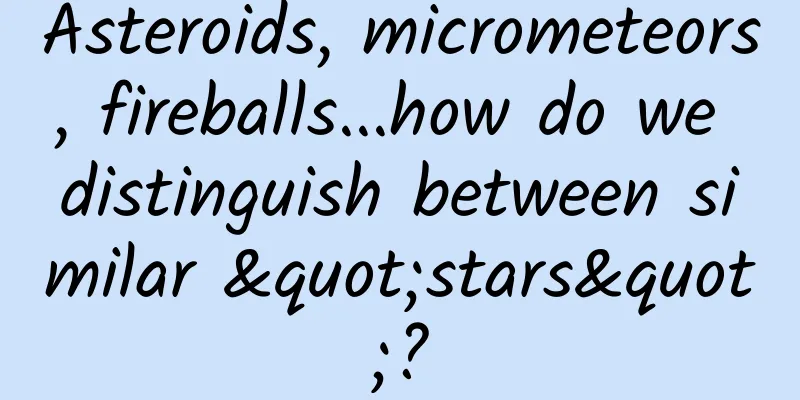Asteroids, micrometeors, fireballs...how do we distinguish between similar "stars"?

|
According to the solar nebula theory, the solar system is a nebula disk composed of dust and gas, which was formed by accretion under the action of gravity. Most of the matter in the solar nebula formed the sun, the eight planets and their satellites and dwarf planets, forming the main structure of the solar system. The remaining "bricks and tiles" scattered in orbit formed the small celestial bodies scattered all over the sky. Figure 1 From the Solar Nebula to the Solar System Small celestial bodies are celestial bodies that orbit the sun and are significantly smaller in size and mass than planets and dwarf planets. Small celestial bodies include asteroids and comets. Comets contain more volatile substances such as water ice, and when they are close to the sun, a bright tail can generally be observed. Figure 2 Asteroids (left) and comets (right) Asteroids and comets with a diameter of less than 1 meter are also called micrometeoroids. Meteors are the luminous phenomena produced by small celestial bodies and micrometeoroids entering the Earth's atmosphere at high speed. Meteor showers are the phenomenon that when a group of meteors encounters the Earth, people will see a significant increase in meteors in a certain area of the sky. The parent body of a meteor shower is generally believed to be a comet. Figure 3 Meteor shower Fireballs are the luminous phenomena produced when a large meteor enters the lower atmosphere and continues to burn without completely burning in the upper atmosphere. Not only are they extremely bright, but sometimes they also make sounds. Meteorites are formed when meteoroids fall on land. Meteorites are an important source of samples for human research on asteroids. Figure 4 Fireball (left) and meteorite (right) In terms of material origin, asteroids, like the eight planets, originated from the solar nebula, so their material composition is basically the same. However, due to their small size, most asteroids have not experienced differentiation, nor weather and geological phenomena such as clouds, rain, volcanoes, and earthquakes. Therefore, most asteroids still retain the original material composition of the early formation of the solar system. The exploration of asteroids is of great significance to the study of major scientific issues such as the origin and evolution of the solar system, the origin of life and water on Earth, etc. Okay, now do you understand the differences and connections between these concepts? |
<<: Free as a fish! All humans need to survive in the ocean is a gill?
Recommend
Treating AI as a human? Wrong!
[Editor's Note] Human scientists and entrepre...
Is it because of lack of vitamin D that you always get insufficient sleep? The real reason is...
Review | Ruan Guangfeng, Deputy Director of Kexin...
Why does the spring breeze not reach Yumen Pass? Look at the map and you will see the answer.
"The Yellow River flows far away among the w...
New progress in DNA digital storage technology →
With the explosive growth of digital data product...
What are the effects of Huanghuali Chinese medicine?
I believe that many friends with weak constitutio...
DHL: 2023 Global Online Shopping Consumer Survey Report
DHL released the "2023 Global Online Shoppin...
@If you often watch short videos, your brain may be affected!
To reduce the time spent on short videos and get ...
Will keeping leafy vegetables in the refrigerator for 24 hours cause cancer? Will eating potatoes refrigerated in the refrigerator cause poisoning? The truth is →
Author: Wang Yanli, registered dietitian Reviewer...
Fun fact: What other uses do pigs have besides providing meat for humans?
Pigs are the most common livestock among all live...
Zhejiang University study: Eating one more egg a day may increase the risk of death from heart disease and cancer? Is it credible?
"Don't you know that eating too many egg...
What is the medicinal value of stone touch?
The medicinal value of the medicinal herb Shichu ...
The efficacy and function of duck foot wood bark
Schefflera bark is a common Chinese medicinal mat...
In summer, you must deworm your cats and dogs! But how to use toxic deworming medicine?
Summer is here, remember to deworm your pet regul...
The efficacy and function of red root
There are so many medicinal herbs in the world, a...
Top five disaster reduction emergency rumor-busting lists
This article was published by the official accoun...









